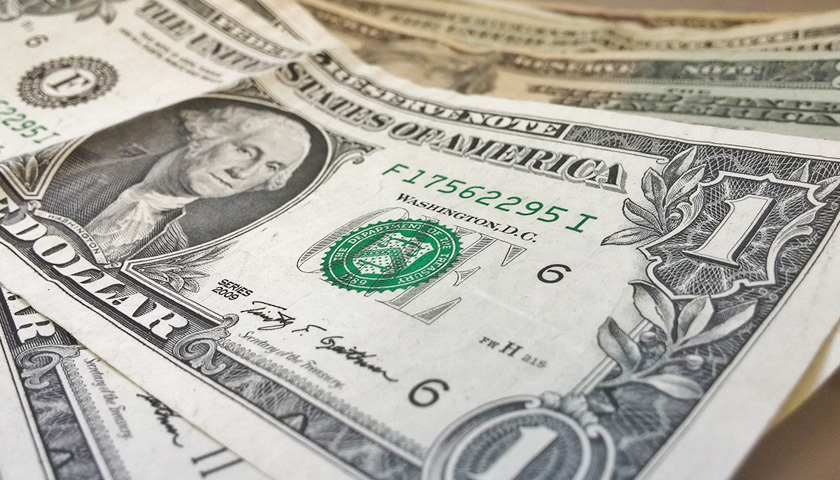by Micaela Burrow
Russia, China and other countries have escalated efforts to ditch transactions made with U.S. dollars in 2022, helping them bypass Western sanctions and keep their economies afloat.
Since Western countries levied heavy sanctions on Russia in punishment for its invasion of Ukraine, India has increased its imports of Russian coal and natural gas, paying in Chinese yuan, United Arab Emirates dirham, Hong Kong dollar, and euro, Reuters reported Wednesday. Turkey and Iran have also forged agreements with Russia to base bilateral commerce on the Russian ruble, an effort to divest from dependence on the “toxic” U.S. dollar while easing the effect of sanctions on the Russian economy.
“The current round of turbulence is likely to increase … momentum in the creation of a rival reserve currency or currencies to help supplant the oversized role of the dollar,” Anthony Kim, a research fellow at the Heritage Foundation specializing in international economic issues, told the Daily Caller News Foundation.
 The dollar comprised 60% of countries’ foreign exchange reserves, used to trade with one another, in 2021, and dominates international transactions, according to the U.S. Federal Reserve Board. U.S. sanctions cut off countries from accessing dollars for international trade.
The dollar comprised 60% of countries’ foreign exchange reserves, used to trade with one another, in 2021, and dominates international transactions, according to the U.S. Federal Reserve Board. U.S. sanctions cut off countries from accessing dollars for international trade.
Beyond agreeing on July 19 to launch a ruble-Iranian rial currency exchange, Moscow and Tehran have strengthened cooperation between their major banking systems and set up a trade center owned by Russia’s Mir Business Bank and Iran’s Bank Melli, Iranian state-run Tasnim News reported.
Iranian state media said the purpose of these agreements is to develop an “alternative to SWIFT,” a widely-used banking telecommunications system. Western countries have cut off Iranian and Russian financial institutions from the system as a way to slow down their banking transactions and impose consequences for bad behavior.
Iran conducted its first cryptocurrency-based import order Tuesday, experimenting with digital assets to bypass U.S. sanctions, Reuters reported. The U.S. has a nearly complete embargo on Iranian oil, banking and shipping sectors.
Kremlin spokesman Dmitry Peskov said Russia intended to completely eliminate trade with Iran based on the U.S. dollar in an interview with Iran’s state broadcasting corporation, helping both countries mitigate U.S. sanctions and reducing financial volatility, Tasnim reported.
The U.S. sanctioned a portion of Russia’s oil and gas exports in March, but the U.S. and Europe have thus far left most of Russia’s energy industry untouched. The EU plans to phase out Russian gas exports by two-thirds over the coming year, according to the BBC, but will still allow exports to third countries, Reuters reported.
Most of Russian crude oil has found new buyers in Asia, especially Turkey and India, boosting Russian energy production nearly to pre-war levels and nudging prices upward, according to Bloomberg’s Javier Blas.
Turkish President Recep Tayyip Erdogan said Saturday that he had agreed to begin paying for a portion of imported Russian gas in rubles during a return trip from a meeting with Russian President Vladimir Putin in Sochi, AFP reported.
“One good thing about this Sochi visit is that we agreed on the ruble with Mr. Putin,” Erdogan said. “Since we will conduct this trade in rubles, it will of course bring money to Turkey and Russia.”
Indian companies bought 742,000 tons of Russian coal in June, equaling nearly half of total Russian imports that month, with alternative currencies, Reuters reported, citing customs documents compiled by an Indian trade source and shared with the outlet. Traders said that India finances the majority of its commodity imports with dollars.
Traders also told Reuters they expected the share of Russian coal paid for in non-dollar currencies to increase, even though Indian firms can purchase Russian coal in dollars without running afoul of U.S. sanctions.
.@SecBlinken: Though the Kremlin is working hard to paint a picture of economic stability, the facts show otherwise. The powerful impact of sanctions will grow and compound over time. pic.twitter.com/dbBji0J15P
— Department of State (@StateDept) July 27, 2022
“If commodities such as oil and other raw materials were priced in an alternative currency whose value is tied to commodities and less volatile than the dollar, this could reduce financial market instability in emerging economies in the long run,” said Kim. However, it’s unclear whether a viable alternative currency exists, he added.
“The Chinese are gearing up for a valiant effort to promote the yuan into the big leagues,” but China’s slowing economy and widespread distrust of Chinese financial management will likely prevent the yuan from supplanting the dollar, Kim explained.
Nevertheless, the volume of yuan-ruble trading surged over 1,000% from February, when Russia invaded Ukraine, to May, according to Bloomberg. At the same time, the share of yuan in international transactions plummeted.
U.S. dollar hegemony is not going away any time soon, Kim told the DCNF. “The bottom line is that with all of its … alleged or real downsides, the U.S. dollar has proved its resilience” and “credibility over time.”
– – –
Micaela Burrow is a reporter at Daily Caller News Foundation.




